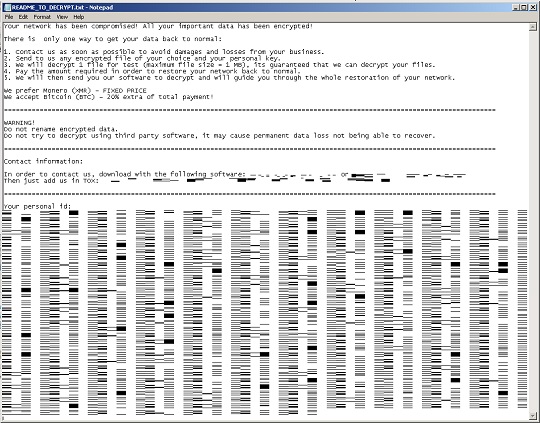Ransom.Win32.KUIPER.THAAHBC
Ransom:Win64/Lockbit.BMC!MTB (MICROSOFT); UDS:Trojan-Ransom.Win32.Generic (KASPERSKY)
Windows


Threat Type: Ransomware
Destructiveness: No
Encrypted: No
In the wild: Yes
OVERVIEW
This Ransomware arrives on a system as a file dropped by other malware or as a file downloaded unknowingly by users when visiting malicious sites.
It drops files as ransom note. It avoids encrypting files with the following file extensions.
TECHNICAL DETAILS
Arrival Details
This Ransomware arrives on a system as a file dropped by other malware or as a file downloaded unknowingly by users when visiting malicious sites.
Installation
This Ransomware adds the following processes:
- cmd.exe /c "vssadmin resize shadowstorage /for={Drives A-Z}: /on=C: /maxsize=401MB"
- cmd.exe /c "wevtutil cl application"
- cmd.exe /c "wbadmin delete catalog -quiet"
- cmd.exe /c "bcdedit /set {default} recoveryenabled No"
- cmd.exe /c "wbadmin DELETE SYSTEMSTATEBACKUP -deleteOldest"
- cmd.exe /c "wevtutil cl securit"
- cmd.exe /c "bcdedit /set {default} bootstatuspolicy ignoreallfailures"
- cmd.exe /c "wbadmin DELETE SYSTEMSTATEBACKUP"
- cmd.exe /c "wevtutil cl system"
- cmd.exe /c "powershell.exe -ep bypass -ec {Base64-encoded powershell script}"
The following processes will spawned as a result of this command:- powershell.exe -ep bypass -w hidden -c "while($true){ taskkill /f /im taskkill.exe}"
- powershell.exe -ep bypass -w hidden -c "while($true){ taskkill /f /im tasklist.exe}"
- powershell.exe -ep bypass -w hidden -c "while($true){ taskkill /f /im taskmgr.exe}"
- powershell.exe -ep bypass -w hidden -c "while($true){ taskkill /f /im cmd.exe}"
- powershell.exe -ep bypass -w hidden -c "while($true){ taskkill /f /im ps.exe}"
- cmd.exe /c taskkill /f /im {Process name from Termination list}
- cmd.exe /c net stop {Service name from Termination list} /y
- cmd.exe /c "shutdown /r /t 8"
- cmd.exe /c "reboot"
Process Termination
This Ransomware terminates the following services if found on the affected system:
- via net stop:
- Avast Antivirus!
- TMResponse
- BackupExecAgentBrowser
- AOTAgentSvc
- TMBMServer
- iVPAgent
- Trend Micro
- Web Service Communicator
- Tmccst
- Tmlisten
- Ntrtscan
- TmWSCSvc
It terminates the following processes if found running in the affected system's memory:
- via taskkill /f /im:
- AOTAgent.exe
- CETASvc.exe
- powerpnt.exe
- iVPAgent.exe
- tmwscsvc.exe
- ResponseService.exe
- PccNTMon.exe
- SupportConnector.exe
- vastsvc.exe
- avgsvc.exe
- NortonSecurity.exe
- McAfeeFramework.exe
- KasperskyService.exe
- SophosSAU.exe
Other Details
This Ransomware does the following:
- It prints the number of processors and execution logs to the console.

- It checks if the file size is greater than 198, 180, 854 bytes. These files will be partially encrypted for faster encryption.
- It checks if the file extension is any of the following. These files will be encrypted in its entirety regardless of the file size.
- .sql
- .txt
- .db
- .json
It accepts the following parameters:
- --help → Displays the help menu.
- -bm {yes|no} → Big mode ensures that large files encrypted first. (Default value: yes)
- -kill {yes|no} → Enables/disables the kill loop for the following applications: taskmgr, cmd, regedit, powershell. (Default value: no)
- -note {yes|no} → Defines whether the ransom note is dropped during the encryption process, or only once the encryption is finished. (Default value: yes)
- -p {path} → Specifies the targeted folder to encrypt files
- -reboot {yes|no} → Defines whether machine is rebooted after encryption. (Default value: yes)
- -rename {yes|no}→ Specifies if the ransom extension is appended to encrypted files. (Default value: yes)
Ransomware Routine
This Ransomware avoids encrypting files with the following strings in their file path:
- README_TO_DECRYPT.txt
- Program Files (x86)
- Windows
- Temp
- System32
- AppData
- SysWOW64
- BOOTNXT
- DumpStack.log.tmp
- pagefile.sys
- swapfile.sys
- desktop.ini
- ntuser.dat
- thumbs
- System Volume Information
- $Recycle.Bin
- perflogs
- App Data
- appdata
- ProgramData
- Recovery
It appends the following extension to the file name of the encrypted files:
- .kuiper
It drops the following file(s) as ransom note:
- {Encrypted Drive}\README_TO_DECRYPT.txt
- {Encrypted Directory}\README_TO_DECRYPT.txt

It avoids encrypting files with the following file extensions:
- .DAT
- .TMP
- .bak
- .bat
- .bin
- .blf
- .cfg
- .cmd
- .com
- .dat
- .dll
- .elf
- .exe
- .ini
- .lnk
- .msi
- .rtf
- .sys
- .tmp
- .desktop
- .Desktop
- .so
- .go
- .html
- .crlk
- .kuiper
SOLUTION
Step 1
Trend Micro Predictive Machine Learning detects and blocks malware at the first sign of its existence, before it executes on your system. When enabled, your Trend Micro product detects this malware under the following machine learning name:
-
Troj.Win32.TRX.XXPE50FFF077
Step 2
Before doing any scans, Windows 7, Windows 8, Windows 8.1, and Windows 10 users must disable System Restore to allow full scanning of their computers.
Step 3
Note that not all files, folders, and registry keys and entries are installed on your computer during this malware's/spyware's/grayware's execution. This may be due to incomplete installation or other operating system conditions. If you do not find the same files/folders/registry information, please proceed to the next step.
Step 4
Restart in Safe Mode
Step 5
Search and delete files detected as Ransom.Win32.KUIPER.THAAHBC
- {Encrypted Drive}\README_TO_DECRYPT.txt
- {Encrypted Directory}\README_TO_DECRYPT.txt
Step 6
Restart in normal mode and scan your computer with your Trend Micro product for files detected as Ransom.Win32.KUIPER.THAAHBC. If the detected files have already been cleaned, deleted, or quarantined by your Trend Micro product, no further step is required. You may opt to simply delete the quarantined files. Please check this Knowledge Base page for more information.
Step 7
Restore encrypted files from backup.
Did this description help? Tell us how we did.


